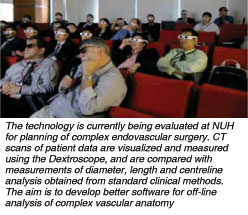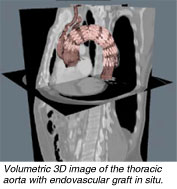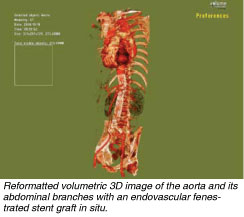|
by Peter ROBLESS
 he aorta - the largest artery in your body - carries blood away from your heart. The aorta runs through your chest, where it is called the thoracic aorta. When it reaches your abdomen, it is called the abdominal aorta. The abdominal aorta supplies blood to the lower half of the body. Just below the abdomen, the aorta splits into two branches that carry blood into each leg. When a weak area of the abdominal aorta expands or bulges, it is called an abdominal aortic aneurysm (AAA). The pressure from blood flowing through your abdominal aorta can cause a weakened part of the aorta to bulge, much like a balloon. However, an AAA can stretch and weaken the aorta. Aneurysms are a health risk because they can burst, or rupture. A ruptured aneurysm or blowout can cause severe internal bleeding leading to shock or even death. Clots or debris can also form inside the aneurysm and travel downstream to other blood vessels damaging other organs in your body. If one of these blood vessels becomes blocked, it can cause severe pain or even limb loss. It is unclear at present what causes an AAA. The current opinion is that aneurysms may be caused by inflammation in the aorta, which may cause its wall to break down. Some researchers believe that this inflammation can be associated with atherosclerosis (also called hardening of the arteries) or risk factors that contribute to atherosclerosis, such as high blood pressure (hypertension). he aorta - the largest artery in your body - carries blood away from your heart. The aorta runs through your chest, where it is called the thoracic aorta. When it reaches your abdomen, it is called the abdominal aorta. The abdominal aorta supplies blood to the lower half of the body. Just below the abdomen, the aorta splits into two branches that carry blood into each leg. When a weak area of the abdominal aorta expands or bulges, it is called an abdominal aortic aneurysm (AAA). The pressure from blood flowing through your abdominal aorta can cause a weakened part of the aorta to bulge, much like a balloon. However, an AAA can stretch and weaken the aorta. Aneurysms are a health risk because they can burst, or rupture. A ruptured aneurysm or blowout can cause severe internal bleeding leading to shock or even death. Clots or debris can also form inside the aneurysm and travel downstream to other blood vessels damaging other organs in your body. If one of these blood vessels becomes blocked, it can cause severe pain or even limb loss. It is unclear at present what causes an AAA. The current opinion is that aneurysms may be caused by inflammation in the aorta, which may cause its wall to break down. Some researchers believe that this inflammation can be associated with atherosclerosis (also called hardening of the arteries) or risk factors that contribute to atherosclerosis, such as high blood pressure (hypertension).
 Each year, approximately 200,000 people in the United States are diagnosed with AAA. Of these patients, nearly 15,000 may have AAA dangerous enough to cause death from a ruptured aneurysm. Fortunately, when diagnosed early, AAA can be treated, or even cured, with highly effective and safe treatments. Famous people who have had an AAA include Albert Einstein and Richard Burton. Each year, approximately 200,000 people in the United States are diagnosed with AAA. Of these patients, nearly 15,000 may have AAA dangerous enough to cause death from a ruptured aneurysm. Fortunately, when diagnosed early, AAA can be treated, or even cured, with highly effective and safe treatments. Famous people who have had an AAA include Albert Einstein and Richard Burton.
How is AAA diagnosed?
Some large aneurysms can be felt easily through the abdominal wall but many of them cannot be detected. A large proportion is only found incidentally. Ultrasound is the first choice for detecting an AAA. Once the presence of an AAA is established, other techniques such as Computed Tomography (CT) or Magnetic Resonance Imaging (MRI) may be used to get more precise information.
What is the treatment of AAA?
- Open Surgical Aneurysm Repair
During an open aneurysm repair, also known as surgical aneurysm repair, your surgeon makes an incision in your abdomen and replaces the weakened part of your aorta with a tube-like replacement called an aortic graft. This graft is made of strong man-made material, such as Dacron, in the size and shape of the healthy aorta. The strong tube takes the place of the weakened section in your aorta and allows your blood to pass through it easily.

- Endovascular Stent Graft
An alternative to open aneurysm repair is a newer procedure called endovascular stent graft. Endovascular means that the treatment is performed inside your body using long, thin tubes called catheters that are threaded through the blood vessels. In recent years, the endovascular treatment of AAA has emerged as a minimally invasive alternative to open surgery repair. The first endovascular exclusion of an aneurysm took place in Argentina by Dr Parodi and his colleagues in 1991. This technique has since been reported to have a lower mortality rate compared to open surgical repair, and is now being widely used in individuals with other medical conditions that make them high-risk patients for open surgery. There have also been many reports concerning the endovascular treatment of ruptured AAA, which are usually treated with an open surgery repair due to the patient¡¯s overall impaired condition. Mid-term results have been quite promising. The continuous development of the available endovascular stent graft technology in conjunction with the improvements in vascular imaging will further enhance its safety and efficacy in years to come.
However, this procedure requires more frequent imaging procedures after placement to ensure that the graft continues to function properly, and also, periodic maintenance is more likely to be required than the open procedure. In addition, not every patient may be suitable to undergo this procedure, since not all patients are candidates for endovascular repair because of the extent of the aneurysm, and its relationship to the renal (kidney) arteries, or other issues. While endovascular stent graft may be a good option for some patients, in some other cases, open aneurysm repair may still be the best way to treat AAA.
Innovations in the Treatment of Aortic Aneurysms at National University Hospital (NUH), Singapore
With the recent development of endovascular surgery, many patients now benefit from less invasive means of treating their vascular disease. Aneurysms in the chest or abdomen, aortic dissection, aorto-iliac and lower-extremity occlusive disease can often be managed with minimally invasive endovascular techniques. Endovascular techniques are an especially attractive option for those patients who are not suitable for open surgical repair due to their medical co-morbidities. In addition to standard open surgical procedures, the endovascular team at NUH is competent in these minimally invasive techniques, such as angioplasty and stenting for occlusive lesions and placing aortic stent grafts for aneurysmal disease in the thorax or abdomen.
The latest advances in aortic stent graft technology now allow for customization of aortic stents for patients with complex anatomy. This includes the use of branch grafts and fenestrations specifically designed for the kidney and gut arteries. These techniques require precise imaging, planning and placement of these devices within the patients diseased aorta. This may extend the use of minimally invasive aortic stenting in patients with difficult anatomy who are not fit for major surgery. Other patients with more extensive aneurysms may benefit from hybrid procedures involving bypass surgery in conjunction with endovascular stenting. In both of these areas, the key to success is good planning which requires excellent visualization.
Innovations in Visualization
 These advances go hand in hand with innovations in vascular imaging for planning and visualization of the vascular tree. One such collaboration is with Volume Interactions, a Singapore firm, using their homegrown technology for 3D visualization of complex vascular anatomy. This technology is called Dextroscope which supports surgical evaluation and decision-making at a level previously only imagined and gives an unprecedented understanding of complex anatomical relationships and pathology. These advances go hand in hand with innovations in vascular imaging for planning and visualization of the vascular tree. One such collaboration is with Volume Interactions, a Singapore firm, using their homegrown technology for 3D visualization of complex vascular anatomy. This technology is called Dextroscope which supports surgical evaluation and decision-making at a level previously only imagined and gives an unprecedented understanding of complex anatomical relationships and pathology.
With the Dextroscope, the user is able to interact with volumetric 3D objects easily and intuitively and have an idea of the anatomy and access to plan the operation. The Dextroscope puts complete control of the volumetric images in your hands, allowing you to see and interact with them in a natural, intuitive manner. The user is able to interact intuitively with a unique virtual interface using both hands, unconstrained by the limitations of a keyboard and mouse. The reformatted volumetric 3D images are co-located in the same position in real time and can be manipulated in the axial, coronal, and sagittal planes, any oblique plane, or any displayed volume, individually or simultaneously. These volumetric interactive 3D images provide an increased understanding of spatial relationships, angulation and tortousity. The Dextroscope also has PACS (picture archiving and communication systems) connectivity and DICOM (Digital Imaging and Communications in Medicine) network functions to simplify image acquisition. Stereoscopic playback and video export capabilities, such as digital movie recording, streamline the sharing of information for consultation and educational purposes.
 Click here to download the full issue for USD 6.50 Click here to download the full issue for USD 6.50
|


 he aorta - the largest artery in your body - carries blood away from your heart. The aorta runs through your chest, where it is called the thoracic aorta. When it reaches your abdomen, it is called the abdominal aorta. The abdominal aorta supplies blood to the lower half of the body. Just below the abdomen, the aorta splits into two branches that carry blood into each leg. When a weak area of the abdominal aorta expands or bulges, it is called an abdominal aortic aneurysm (AAA). The pressure from blood flowing through your abdominal aorta can cause a weakened part of the aorta to bulge, much like a balloon. However, an AAA can stretch and weaken the aorta. Aneurysms are a health risk because they can burst, or rupture. A ruptured aneurysm or blowout can cause severe internal bleeding leading to shock or even death. Clots or debris can also form inside the aneurysm and travel downstream to other blood vessels damaging other organs in your body. If one of these blood vessels becomes blocked, it can cause severe pain or even limb loss. It is unclear at present what causes an AAA. The current opinion is that aneurysms may be caused by inflammation in the aorta, which may cause its wall to break down. Some researchers believe that this inflammation can be associated with atherosclerosis (also called hardening of the arteries) or risk factors that contribute to atherosclerosis, such as high blood pressure (hypertension).
he aorta - the largest artery in your body - carries blood away from your heart. The aorta runs through your chest, where it is called the thoracic aorta. When it reaches your abdomen, it is called the abdominal aorta. The abdominal aorta supplies blood to the lower half of the body. Just below the abdomen, the aorta splits into two branches that carry blood into each leg. When a weak area of the abdominal aorta expands or bulges, it is called an abdominal aortic aneurysm (AAA). The pressure from blood flowing through your abdominal aorta can cause a weakened part of the aorta to bulge, much like a balloon. However, an AAA can stretch and weaken the aorta. Aneurysms are a health risk because they can burst, or rupture. A ruptured aneurysm or blowout can cause severe internal bleeding leading to shock or even death. Clots or debris can also form inside the aneurysm and travel downstream to other blood vessels damaging other organs in your body. If one of these blood vessels becomes blocked, it can cause severe pain or even limb loss. It is unclear at present what causes an AAA. The current opinion is that aneurysms may be caused by inflammation in the aorta, which may cause its wall to break down. Some researchers believe that this inflammation can be associated with atherosclerosis (also called hardening of the arteries) or risk factors that contribute to atherosclerosis, such as high blood pressure (hypertension).
 Each year, approximately 200,000 people in the United States are diagnosed with AAA. Of these patients, nearly 15,000 may have AAA dangerous enough to cause death from a ruptured aneurysm. Fortunately, when diagnosed early, AAA can be treated, or even cured, with highly effective and safe treatments. Famous people who have had an AAA include Albert Einstein and Richard Burton.
Each year, approximately 200,000 people in the United States are diagnosed with AAA. Of these patients, nearly 15,000 may have AAA dangerous enough to cause death from a ruptured aneurysm. Fortunately, when diagnosed early, AAA can be treated, or even cured, with highly effective and safe treatments. Famous people who have had an AAA include Albert Einstein and Richard Burton.

 These advances go hand in hand with innovations in vascular imaging for planning and visualization of the vascular tree. One such collaboration is with Volume Interactions, a Singapore firm, using their homegrown technology for 3D visualization of complex vascular anatomy. This technology is called Dextroscope which supports surgical evaluation and decision-making at a level previously only imagined and gives an unprecedented understanding of complex anatomical relationships and pathology.
These advances go hand in hand with innovations in vascular imaging for planning and visualization of the vascular tree. One such collaboration is with Volume Interactions, a Singapore firm, using their homegrown technology for 3D visualization of complex vascular anatomy. This technology is called Dextroscope which supports surgical evaluation and decision-making at a level previously only imagined and gives an unprecedented understanding of complex anatomical relationships and pathology.
 Click here to download the full issue for USD 6.50
Click here to download the full issue for USD 6.50